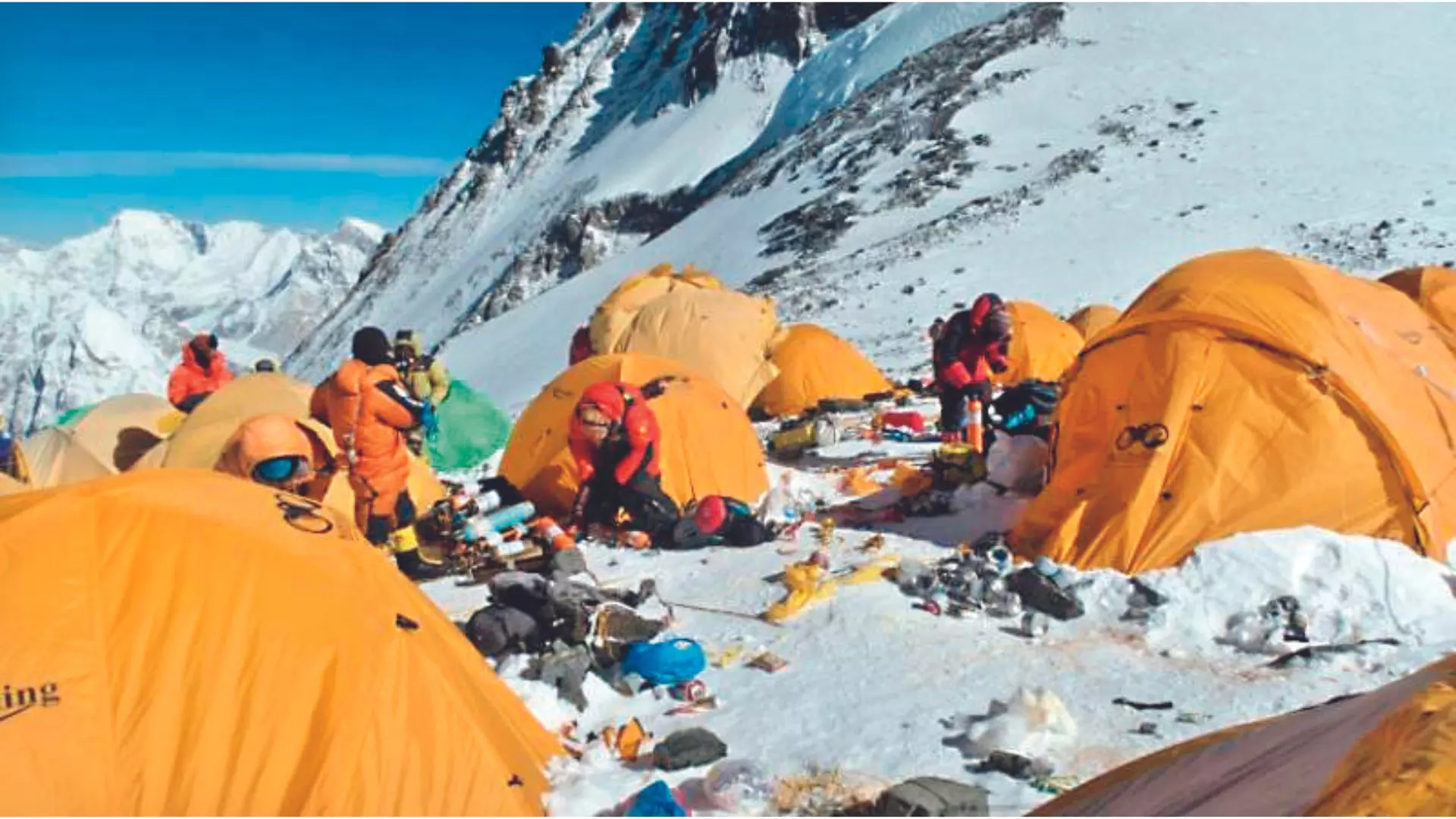Peak trash
With more and more people visiting it each year, Mount Everest has grown increasingly polluted

The route of the most well-known hike in the world is littered with several tents, empty oxygen bottles, steel bowls, spoons, sanitary pads, paper and trash. Approximately 800 people attempt to climb Everest annually.
The Sagarmatha National Park receives 900-1,000 tonnes of solid trash annually. Though it’s undeniably good for the economy, the growing number of visitors to Sagarmatha National Park — home of Everest Base Camp — has also brought forth problems that should worry any prudent traveller.
As the Everest climbing season gets underway, mountaineers claim that the EBC region has always been susceptible to environmental damage brought on by overindulgent human activity.
Challenges for the ecosystem
Over 800 individuals attempt to summit Mount Everest each climbing season during the few weeks of the year when the weather is ideal. This inflow poses significant problems to this fragile ecosystem, the animals that dwell there, and the local communities that call it home. What are the most sustainable ways to get to Everest Base Camp? And how can one accomplish this?
What a trash
According to Kunal Sanklecha, a climber, changemaker, educator, and the founder of The Infinite Playground, during the summit, each individual generates approximately eight kilogrammes (18 pounds) of trash, the majority of which is left on the mountain. “Waste from Himalayan hikes might include empty butane cans, food waste, packaging (plastic MLP garbage), human waste (poop), batteries, and so forth.”
“A lot of it depends on how the trek logistics are planned and the number of people,” adds Kunal, who incorporates sustainability and composting into the treks he leads.
While a climbing ban on Mt. Everest is not an option for the Nepalese government, every government in the world — whose citizens make up the hundreds of foreign climbers bidding to climb Everest — has an ethical and moral obligation to ensure that the peak is clean.
Parth Upadhyay a professional mountaineer, who has been climbing mountains since he was fifteen. Since 2015, he has led hikes and excursions throughout the Himalayas and beyond. Parth claims that a small group of inexperienced climbers is “enough to have a profound effect.” Parth, who has led over 1,500 treks, says, “Every experienced trekker understands that trekking is all about teamwork. Thus, when trekking in a group, the team must cooperate.”
Trash to treasure
“To reduce littering, we advise trekkers to bring their own mug or cup. To reduce waste, trekkers must plan ahead of time and put useful items on their list of things to bring.” Kunal recommends carrying a simple serviette, cloth pads or cups, cloth diapers and an eco-bag per person to store the waste they are likely to make.
Peak Poop
‘Poo bags’ is a hotly debated topic, particularly on large mountains like Everest. “Every year, before the start of the season, certain eye-catching headlines appear. However, the ground realities are completely different. While some NGOs and trek/expedition organisers have worked to solve the problem by using bio-toilets or poop bags to bring your poop down, given the challenges in the big mountains and higher altitudes, most of them aren’t able to execute it effectively” says Kunal, adding, “Human poop freezes in those temperatures, especially in higher camps, and stays forever. Given the difficulties, adhering to “leave no trace” on Everest is extremely important. The poisoning of glaciers and, eventually, drinking water for the settlements below is severe.”
What goes up must come down
Anyone visiting Mount Everest must pay a $4,000 deposit, which is repaid if they return with eight kilogrammes (18 pounds) of garbage—the average amount produced by a single person during the journey. It is not just local governments attempting to make a difference.
“Most imported meals contain plastic, glass, or tin, adding to the lovely environment’s garbage. Remember to eat local organic food,” urges Kuntal A. Joisher, the world’s first vegan to summit Mt Everest.
“Keep a trash bag and pair of gloves handy to remove the waste from trails if you can; go the extra mile and bring it down to the nearest base village or city for effective disposal,” says Kunal. He goes on to say, “Single-use sanitary pads, diapers, and wet wipes are not recommended to be disposed of on the mountain as they would take 100s of years to decompose.”
Leave no trace
The first basic premise of outdoor safety and environmental stewardship is to leave no trace. “It is important and must be strictly enforced because there are a large number of irresponsible trekkers who generate waste and dispose of it carelessly, causing it to remain in the mountains for hundreds of years,” says Kunal.
Overall phenomenon
Carry large garbage bags for dry waste generated on treks.
Plastic and packaging waste are returned to their original location.
If it is a day walk, return rubbish to the city. For longer treks, try to engage with local NGOs such as Waste Warriors and Healing Himalayas, which work on grassroots waste removal and management.
There are a large number of irresponsible trekkers who generate waste and dispose of it carelessly, causing it to remain in the mountains for hundreds of years. Kunal Sanklecha, mountaineer
Climbers must pay a $4,000 deposit per permit, which is repaid if they return with eight kilogrammes (18 pounds) of garbage
Approx. 800 people attempt to climb Everest annually.
15 days round trip to trek to and from Everest Base Camp. Once at Everest Base Camp it then takes an average of 40 days to climb to the peak of Mt. Everest.
900-1,000 tonne of solid trash receives by Sagar-matha National Park annually
50 tonne is found above Everest Base Camp.
Between Camps One and Four, one to three tonnes of human excrement have been left.

